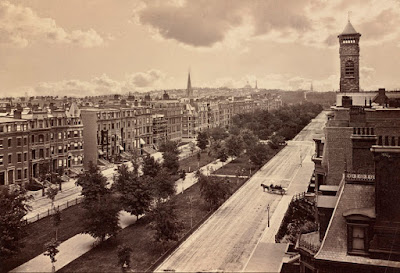But i had another problem besides the one of ears filling with clams and mussels, and that was eyes filling with a brown, smelly substance i recognized from my long experience visiting public toilets and regularly wearing diapers. This all came about from walking to the ICA Boston (Diller, Scofidio & Renfro, which if you've read more of this glob you'll recognize as itself a turd in my mumble opinion, but which in the context of the rest of the mess that's going and gone up in the seaport area of Boston is a masterpiece), filing past horror after horror, shithole after shithole. What a disaster this area is! Why are there so many shitty architects in this city able to build and dominate the only new district possible in this supposedly design savy city? Why and how has this come to be?
Anyone who has studied urban planning knows the history of Boston and it's neighborhoods, planned and unplanned, which comprise some of the best and renowned urban planning in the US, if not the world, with Commonwealth Avenue, the Back Bay, Beacon Hill, Charlestown, and the South End. The Back Bay, in particular, i had in mind when walking the so called Seaport district, a new neighborhood created from scratch from an old industrial wasteland of sorts that was mostly empty, but included the Fort Point industrial area that's full of old brick and timber warehouses that have since been converted to offices and condos, mostly pushing out the artists that first "settled" this area.
If you look at the original maps of the city of Boston and the spit of land that it was settled on, you can understand the need to take and make city from the sea, as the original spot was so constricted there was no way for the city to swallow.
 |
| Current Washington St. is the only connection to land in 1775. |
As has been so well documented by Alex Krueger and David Cobb in their book "Mapping Boston", the history of Boston is a history of taking land from the sea and adjacent swamps and making something from it, usually by flattening the bumps of this spot and using the earth to fill; Beacon Hill is the only hill left untouched. Most renowned of these efforts is Back Bay from the late 19th century, one of the most distinguished and elegant planned residential neighborhoods in the US.
 |
| View down Commonwealth Ave from Public Garden. |
 |
| Commonwealth Ave. |
Comparisons of Back Bay to the Seaport District are telling, and seem almost black and white. i'll grant that time will fill in some of what is so unpleasant about Seaport, but the lack of planning, or rather the lack of quality planning, dooms it be only as good as the buildings that fill that space, which are currently pretty horrible. i think it's the side by side comparison, which is so easy to make in a city like this, that has me feeling bad about this age and the poor quality of space we make for people. It's not about traditional vs modern, it's about good vs bad, the individual do-what-i-want look-at-me vs a recognition that we exist as a collective on a spot of land.

